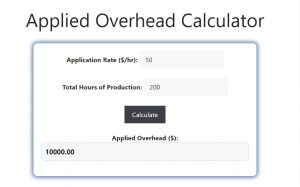About Applied Overhead Calculator (Formula)
The Applied Overhead Calculator is a crucial tool for businesses to accurately allocate indirect costs to production activities. Applied overhead refers to the estimated amount of overhead costs assigned to a specific job or production process based on the application rate and production hours. Understanding applied overhead helps businesses track expenses more accurately and set proper pricing for goods and services.
Formula
The formula for calculating applied overhead is:
Applied Overhead = Application Rate × Total Hours of Production
Where:
- Applied Overhead is the total indirect costs assigned to production.
- Application Rate is the predetermined overhead rate, usually based on estimates of overhead costs.
- Total Hours of Production refers to the number of hours worked on a specific job or project.
How to Use
To use the Applied Overhead Calculator:
- Determine the application rate. This rate can be calculated by dividing estimated overhead costs by an activity base, such as direct labor hours or machine hours.
- Measure the total hours of production related to the project or job.
- Multiply the application rate by the total hours of production to get the applied overhead.
This calculator is useful for companies looking to distribute indirect costs to specific jobs or departments accurately.
Example
Assume that a manufacturing company has an application rate of $50 per hour, and the total production hours for a job is 200 hours. The applied overhead is calculated as:
Applied Overhead = 50 × 200
Applied Overhead = $10,000
This means that $10,000 in overhead costs will be allocated to the job based on the application rate and production time.

FAQs
- What is applied overhead?
Applied overhead refers to the portion of indirect costs assigned to production based on a predetermined overhead rate. - Why is it important to calculate applied overhead?
Calculating applied overhead helps businesses allocate indirect costs accurately, ensuring proper cost control and pricing decisions. - What is the difference between applied overhead and actual overhead?
Applied overhead is the estimated amount assigned to a job, while actual overhead refers to the real, incurred overhead costs during production. - How do I determine the application rate?
The application rate is typically determined by dividing estimated overhead costs by an activity base, such as direct labor hours or machine hours. - What is included in overhead costs?
Overhead costs include indirect expenses such as rent, utilities, depreciation, maintenance, and administrative costs. - Can applied overhead change over time?
Yes, applied overhead can change if the application rate is updated or if the total production hours for a job are revised. - What is the difference between direct and indirect costs?
Direct costs are directly tied to production, like raw materials and labor, while indirect costs, such as rent and utilities, are considered overhead. - What happens if applied overhead is greater than actual overhead?
If applied overhead is greater than actual overhead, the company has over-applied its costs, and adjustments may need to be made in financial statements. - What happens if applied overhead is less than actual overhead?
If applied overhead is less than actual overhead, the company has under-applied its costs, which may require adjustments to reflect the true expenses. - Can I use this calculator for service-based businesses?
Yes, service-based businesses can also use the applied overhead calculator by estimating overhead costs and assigning them based on labor hours or other activity drivers. - What is the activity base in applied overhead calculation?
The activity base is a measure, such as labor hours, machine hours, or production units, used to allocate overhead costs to jobs. - How often should I update my application rate?
It’s advisable to update the application rate regularly, at least once a year, to ensure it reflects current overhead costs and business conditions. - What industries typically use applied overhead calculations?
Applied overhead calculations are common in manufacturing, construction, and service-based industries where indirect costs need to be allocated to jobs or projects. - Can applied overhead be calculated per product?
Yes, applied overhead can be calculated per product if the total production hours and application rate for each product are known. - What is the relationship between applied overhead and product pricing?
Accurate applied overhead calculations help businesses determine the true cost of production, ensuring proper pricing strategies that cover both direct and indirect costs. - How does applied overhead affect a company’s profitability?
Properly allocating overhead helps businesses set realistic pricing, avoid over- or under-costing jobs, and ultimately impact profitability. - What is the difference between predetermined overhead rate and actual overhead rate?
The predetermined overhead rate is based on estimated costs, while the actual overhead rate is calculated after the fact, using real data from production. - Can the applied overhead calculator be used for job costing?
Yes, applied overhead is a crucial component in job costing, ensuring that all indirect costs are accounted for when evaluating the total cost of a project. - Is applied overhead only used for large companies?
No, applied overhead calculations are useful for businesses of all sizes, especially those that need to allocate indirect costs across multiple jobs or departments. - How can I improve the accuracy of applied overhead calculations?
To improve accuracy, regularly review overhead costs, update application rates, and ensure accurate tracking of production hours.
Conclusion
The Applied Overhead Calculator is an essential tool for businesses looking to allocate indirect costs effectively. By using the formula of application rate multiplied by total hours of production, this tool provides a clear and accurate way to determine how much overhead should be assigned to a particular job or project. Understanding and managing applied overhead is key to controlling costs, setting appropriate prices, and ensuring the overall financial health of your business.